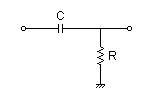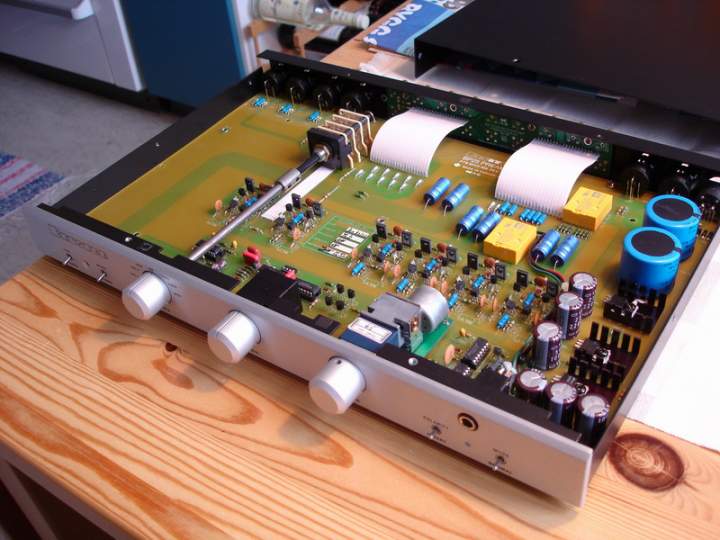Hi !
i have an old Bryston line preamp not used.
I would like to modify it to drive a 600 ohm headphone by Akg.
I read in the specs sheet that the Z out of the preamp is around 50 ohm and i see that the output is AC coupled with a 4 uF film cap.
Only problem should be to change the output capacitor with a bigger one ?
Could i still use it as a line preamp after the mod ?
I found this very useful calculator
http://sim.okawa-denshi.jp/en/CRtool.php

With C= 10 mF and R= 600 ohm (the headphone) i get a Cut-off frequency fc = 26 [Hz]
Now that i think a little i would like to leave the existing film cap and bypass it with a not-polarized 10-20 uF
Would this work ?
Thanks a lot for any advice, gino
i have an old Bryston line preamp not used.
I would like to modify it to drive a 600 ohm headphone by Akg.
I read in the specs sheet that the Z out of the preamp is around 50 ohm and i see that the output is AC coupled with a 4 uF film cap.
Only problem should be to change the output capacitor with a bigger one ?
Could i still use it as a line preamp after the mod ?
I found this very useful calculator
http://sim.okawa-denshi.jp/en/CRtool.php

With C= 10 mF and R= 600 ohm (the headphone) i get a Cut-off frequency fc = 26 [Hz]
Now that i think a little i would like to leave the existing film cap and bypass it with a not-polarized 10-20 uF
Would this work ?
Thanks a lot for any advice, gino
Last edited:
many recommend a 10x margin - so aim for 2 Hz rather than 20
at that size Al electrolytic is the most practical option - "bi-polar" version with considerably higher V rating than signal is the lower measured distortion option by Bateman's "Capacitor Sound" series
Hi thanks a lot indeed for the very kind and valuable reply
So the idea is not that crazy ?
I have thought about this after seeing that many solid state preamps have impressive measurements (for what this can count
I understand that a real world HP is not a pure resistive load but the Bryston seems to have a robust output stage.
It is a discrete op-amp design, a very classical choice for Bryston.
Thanks a lot again, gino
Last edited:
150uF into 600ohm gets you into the right passband territory.
You could use a 150uF bi-polar alone, or two 330uF bi-polar in back to back series for an effective 165uF, or two 330uF polar in back to back series connected, or four 150uF polar in series/parallel connection with each half of the parallel inverted, one half +to+ and the other half-to-.
25V electros will be high enough rating for a +-15Vdc supplied headphone amplifier.
If you use >20Vdc single supply polarity, then use 35V or 50V electros.
You could use a 150uF bi-polar alone, or two 330uF bi-polar in back to back series for an effective 165uF, or two 330uF polar in back to back series connected, or four 150uF polar in series/parallel connection with each half of the parallel inverted, one half +to+ and the other half-to-.
25V electros will be high enough rating for a +-15Vdc supplied headphone amplifier.
If you use >20Vdc single supply polarity, then use 35V or 50V electros.
Last edited:
150uF into 600ohm gets you into the right passband territory. You could use a 150uF bi-polar alone,
Hi and thanks a lot indeed.
I like this solution much more ... any specific suggestion of Brands/series ?
or two 330uF bi-polar in back to back series for an effective 165uF, or two 330uF polar in back to back series connected, or four 150uF polar in series/parallel connection with each half of the parallel inverted, one half +to+ and the other half-to-.
25V electros will be high enough rating for a +-15Vdc supplied headphone amplifier.
If you use >20Vdc single supply polarity, then use 35V or 50V electros.
Voltage rails are +/-24V stabilized with fixed voltage regulators.
I would like to solder them on the existing ones (4uF PP caps) because the traces on the pcb are extremely delicate. I replaced the original MKC 3.3 uF some years ago risking to damage the traces ...
I really would like to be in the brain of some designer when they decide the size of the traces. I like bigger and more robust copper lines.
I have already noticed that the quality on some DIY pcbs are so much better than those on even not cheap commercial units.
This is sincerely unbelievable ...
Thanks a lot again, gino
Last edited:
However, this is a much newer Bryston preamp

i see some blue decoupling caps that indeed look like electrolytic.
But i do not have the schematic to check.
This one is balanced while mine is unbalanced, but there is always gain stages made with discrete op-amps.
Thanks again, gino
i see some blue decoupling caps that indeed look like electrolytic.
But i do not have the schematic to check.
This one is balanced while mine is unbalanced, but there is always gain stages made with discrete op-amps.
Thanks again, gino
Voltage rails are +/-24V stabilized with fixed voltage regulators.
You mean to say they're using 3pin IC regulators? If so then with your 600ohm load there will likely be significant noise generated on the supply lines as IC regs have high-ish output impedance at relatively low currents. I suggest adding more decoupling caps if you like your audio served with its original dynamics
You mean to say they're using 3pin IC regulators?
Hi thanks for the reply and yes. 3pin IC regulators ... fixed voltage.
If so then with your 600ohm load there will likely be significant noise generated on the supply lines as IC regs have high-ish output impedance at relatively low currents. I suggest adding more decoupling caps if you like your audio served with its original dynamics
do you mean caps close to the circuit ? how many uF per rail per channel ?
more or less.
Thanks a lot, gino
AKG's 600-ohm cans have low sensitivity and require high level driving capacity to sound right. You may want to make sure your preamp is capable of at least 10Vp-p output into 600-ohm loads.
I have K240DF, also 600-ohm units, and I drive them with "The Wire SE-SE" designed by Owen. The original The-Wire is a high performance, powerful line buffer with unity gain and was not able to make a noise at normal DAC output level, until I modified the gain setting to give it a +12dB gain to make the phones really sing and slam.
I have K240DF, also 600-ohm units, and I drive them with "The Wire SE-SE" designed by Owen. The original The-Wire is a high performance, powerful line buffer with unity gain and was not able to make a noise at normal DAC output level, until I modified the gain setting to give it a +12dB gain to make the phones really sing and slam.
I mean caps across the supplies to the discrete opamp you mentioned. Closest to the output devices. I'd suggest determining how much capacitance by ear - add until you're satisfied with how it sounds. Start off with 2,200uF per rail per channel.
Hi and thanks a lot again.
2.2mF is a lot indeed. I did not imagine this.
And i think that this could be a reason why some SS headphone amps sound sterile and flat. Their output stages do not have enough juice to push the drivers of the headphones
Thanks again for the very helpful advice.
Regards, gino
AKG's 600-ohm cans have low sensitivity and require high level driving capacity to sound right. You may want to make sure your preamp is capable of at least 10Vp-p output into 600-ohm loads.
Hi and thanks a lot for the very helpful reply.
I had not thought about this and after your advice i have found that they are indeed one of the tough loads around.
I guess here the idea ends ...
I have K240DF, also 600-ohm units, and I drive them with "The Wire SE-SE" designed by Owen. The original The-Wire is a high performance, powerful line buffer with unity gain and was not able to make a noise at normal DAC output level, until I modified the gain setting to give it a +12dB gain to make the phones really sing and slam
Very very interesting. What is this ? where i can find info about it ?
I could use this to buffer the preamp output instead of messing up things
Is there a kit of this buffer ?
The line preamp has a voltage gain of 3 times. I only listen to a dac.
Thanks a lot for the helpful reply, gino
It's in the headphone system section of this site.
http://www.diyaudio.com/forums/vend...jects-available-here-bal-bal-se-se-lpuhp.html
http://www.diyaudio.com/forums/vend...jects-available-here-bal-bal-se-se-lpuhp.html
It's in the headphone system section of this site.
http://www.diyaudio.com/forums/vend...jects-available-here-bal-bal-se-se-lpuhp.html
Thanks a lot indeed. I will read the pages.
As i remember another buffer, the diamond buffer that also should be able to drive many HPs provided the right voltage at its input.
Do you rate the Wire superior ?
Regards, gino
Owen (member name OPC) who designed The Wire made measurement off SE-SE in 2011 and the results were stunning.
http://www.diyaudio.com/forums/head...-headphone-amplifier-pcbs-90.html#post2790636
...and this is my build
http://www.diyaudio.com/forums/head...hread-impressions-gallery-19.html#post3079635
....and this is how the PCB assembly look like
http://www.diyaudio.com/forums/head...hread-impressions-gallery-17.html#post3016257
http://www.diyaudio.com/forums/head...-headphone-amplifier-pcbs-90.html#post2790636
...and this is my build
http://www.diyaudio.com/forums/head...hread-impressions-gallery-19.html#post3079635
....and this is how the PCB assembly look like
http://www.diyaudio.com/forums/head...hread-impressions-gallery-17.html#post3016257
Last edited:
Owen (member name OPC) who designed The Wire made measurement off SE-SE in 2011 and the results were stunning.
http://www.diyaudio.com/forums/head...-headphone-amplifier-pcbs-90.html#post2790636
...and this is my build
http://www.diyaudio.com/forums/head...hread-impressions-gallery-19.html#post3079635
....and this is how the PCB assembly look like
http://www.diyaudio.com/forums/head...hread-impressions-gallery-17.html#post3016257
Hi and thanks a lot for the very helpful advice
Well the measurements are really something ... impressive !
And sincere congratulations for your great creation !
very very beautiful.
Now i need some time to digest all the information.
I have something to do for the weekend
Thanks a lot again, gino
Its not so much about lacking the 'juice' to drive the cans, rather they're introducing too much noise from the power supply. Output stage PSRR is a commonly overlooked issue when opamps are being used (as in the O2) as designers assume the PSRR they'll get in practice is the one shown in the DS. But yes I think its the reason for 'sterile, flat' sound - noise does not get placed into the acoustic space by our cognitive processes so 'hangs around' the transducers so to speak. With speakers this translates into reduced depth.2.2mF is a lot indeed. I did not imagine this.
And i think that this could be a reason why some SS headphone amps sound sterile and flat. Their output stages do not have enough juice to push the drivers of the headphones
- Status
- This old topic is closed. If you want to reopen this topic, contact a moderator using the "Report Post" button.
- Home
- Amplifiers
- Solid State
- Using a line preamp to drive headphone
